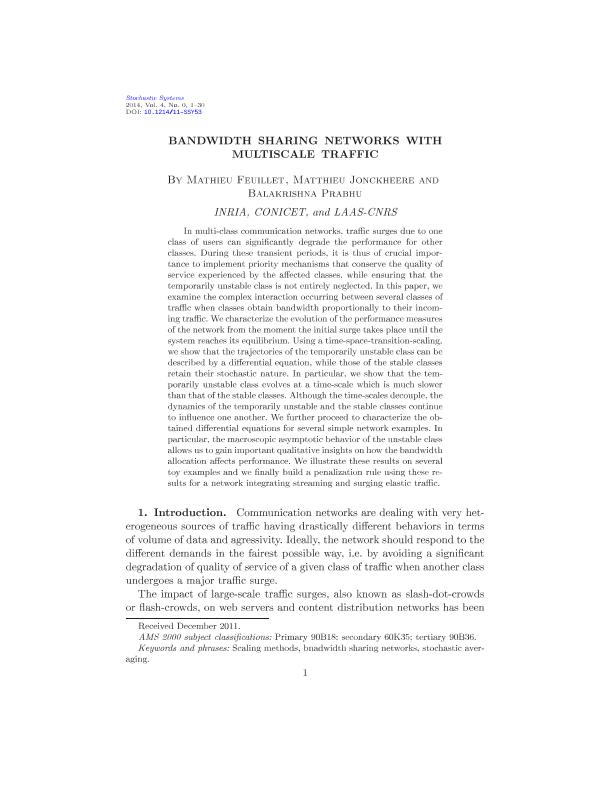Mostrar el registro sencillo del ítem
dc.contributor.author
Feuillet, Mathieu
dc.contributor.author
Jonckheere, Matthieu Thimothy Samson

dc.contributor.author
Prabhu, Balakrishna
dc.date.available
2017-06-26T20:00:50Z
dc.date.issued
2014-05
dc.identifier.citation
Feuillet, Mathieu; Jonckheere, Matthieu Thimothy Samson; Prabhu, Balakrishna; Bandwidth sharing networks with multiscale traffic; INFORMS Applied Probability Society; Stochastic Systems; 4; 5-2014; 1-30
dc.identifier.issn
1946-5238
dc.identifier.uri
http://hdl.handle.net/11336/18918
dc.description.abstract
In multi-class communication networks, traffic surges due to one class of users can significantly degrade the performance for other classes. During these transient periods, it is thus of crucial importance to implement priority mechanisms that conserve the quality of service experienced by the affected classes, while ensuring that the temporarily unstable class is not entirely neglected. In this paper, we examine the complex interaction occurring between several classes of traffic when classes obtain bandwidth proportionally to their incoming traffic. We characterize the evolution of the performance measures of the network from the moment the initial surge takes place until the system reaches its equilibrium. Using a time-space-transition-scaling, we show that the trajectories of the temporarily unstable class can be described by a differential equation, while those of the stable classes retain their stochastic nature. In particular, we show that the temporarily unstable class evolves at a time-scale which is much slower than that of the stable classes. Although the time-scales decouple, the dynamics of the temporarily unstable and the stable classes continue to influence one another. We further proceed to characterize the obtained differential equations for several simple network examples. In particular, the macroscopic asymptotic behavior of the unstable class allows us to gain important qualitative insights on how the bandwidth allocation affects performance. We illustrate these results on several toy examples and we finally build a penalization rule using these results for a network integrating streaming and surging elastic traffic.
dc.format
application/pdf
dc.language.iso
eng
dc.publisher
INFORMS Applied Probability Society
dc.rights
info:eu-repo/semantics/openAccess
dc.rights.uri
https://creativecommons.org/licenses/by-nc-sa/2.5/ar/
dc.subject
Stochastic Networks
dc.subject
Multiscale Traffic
dc.subject
Fluid Limits
dc.subject
Bandwidth Sharing Networks
dc.subject.classification
Matemática Aplicada

dc.subject.classification
Matemáticas

dc.subject.classification
CIENCIAS NATURALES Y EXACTAS

dc.title
Bandwidth sharing networks with multiscale traffic
dc.type
info:eu-repo/semantics/article
dc.type
info:ar-repo/semantics/artículo
dc.type
info:eu-repo/semantics/publishedVersion
dc.date.updated
2017-06-23T14:12:28Z
dc.journal.volume
4
dc.journal.pagination
1-30
dc.journal.pais
Estados Unidos

dc.description.fil
Fil: Feuillet, Mathieu. Institut National de Recherche en Informatique et en Automatique; Francia
dc.description.fil
Fil: Jonckheere, Matthieu Thimothy Samson. Consejo Nacional de Investigaciones Científicas y Técnicas; Argentina
dc.description.fil
Fil: Prabhu, Balakrishna. Centre National de la Recherche Scientifique; Francia
dc.journal.title
Stochastic Systems
dc.relation.alternativeid
info:eu-repo/semantics/altIdentifier/url/http://www.i-journals.org/ssy/viewarticle.php?id=53&layout=abstract
Archivos asociados
